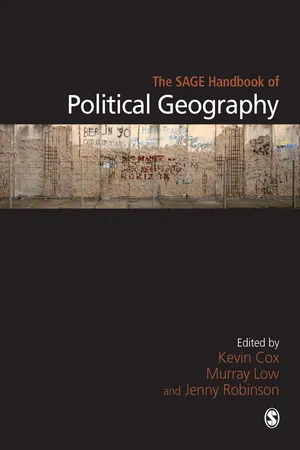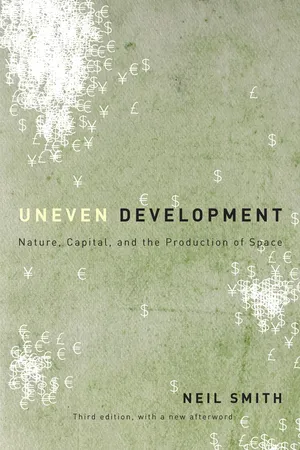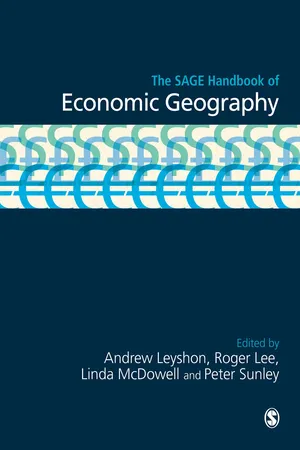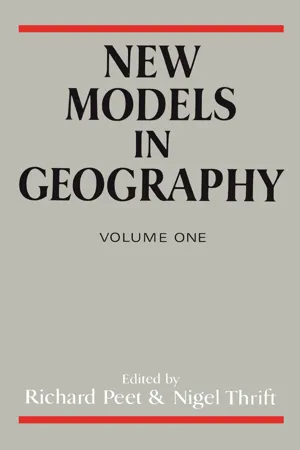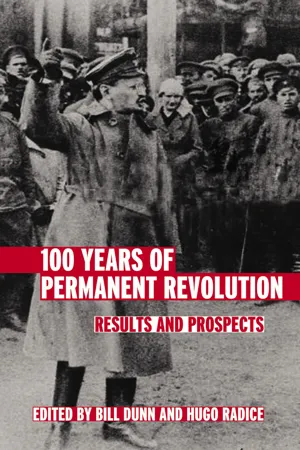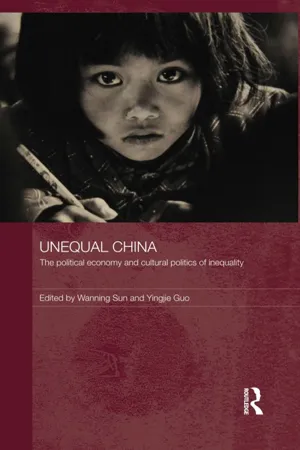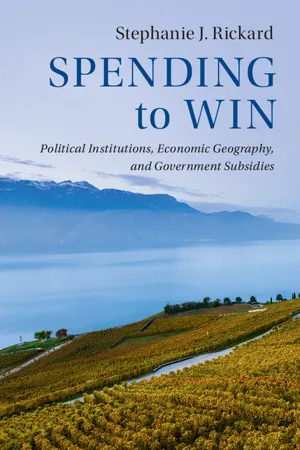Geography
Uneven Development
Uneven development refers to the unequal distribution of economic, social, and political resources across different regions or countries. It highlights disparities in infrastructure, wealth, and opportunities, leading to imbalances in development. This concept is central to understanding the spatial variations in prosperity, poverty, and access to resources within and between different geographical areas.
Written by Perlego with AI-assistance
Related key terms
1 of 5
12 Key excerpts on "Uneven Development"
- eBook - ePub
Spaces of Global Capitalism
A Theory of Uneven Geographical Development
- David Harvey(Author)
- 2019(Publication Date)
- Verso(Publisher)
NOTES TOWARDS A THEORYOF UNEVEN GEOGRAPHICALDEVELOPMENTDavid HarveyNotes towards a theory ofuneven geographical developmentPreambleThe theory of uneven geographical development needs further development. The extreme volatility in contemporary political economic fortunes across and between spaces of the world economy (at all manner of different scales) cry out for better theoretical interpretation. The political necessity is just as urgent since convergence in well-being has not occurred and geographical as well as social inequalities within the capitalist world appear to have increased in recent decades. The promised outcome of poverty reduction from freer trade, open markets and “neo-liberal” strategies of globalization has not materialized. Environmental degradations and social dislocations have also been unevenly distributed. Simultaneously, the uneven geographical development of oppositional movements to neo-liberalism creates both opportunities and barriers in the search for alternatives.There is nothing new, of course, about uneven geographical development within capitalism or, for that matter, within any other mode of production. There are, moreover, several overlapping ways of thinking about it:1) Historicist/diffusionist interpretations treat the political economic development of the advanced capitalist countries (the West) as the engine of capitalism that entrains all other territories, cultures and places into paths of economic, political, institutional and intellectual progress. Uneven geographical development is interpreted as the product of a differentiated diffusion process from the center that leaves behind residuals from preceding eras or meets with pockets of resistance towards the progress and modernization that capitalism promotes. “Backwardness” (the term is highly significant) arises out of an unwillingness or an inability (in racist versions considered innate, in environmentalist versions seen as naturally imposed, and in culturalist versions understood in terms of the weight of historical, religious etc. traditions) to “catch up” with the dynamics of a western-centered capitalism, usually portrayed as the highpoint of modernity or even of civilization. Whole populations, cultures and territories are thereby presumed to be incapable of shaping their own history let alone of influencing developments elsewhere. Occasionally some place “sees the light” (e.g. Japan and more recently much of East and Southeast Asia) and forges ahead. But the rest of the world lives in “the waiting room of history.” There are conservative, liberal and Marxist versions of this historicist/diffusionist argument. - eBook - PDF
- Kevin R Cox, Murray Low, Jennifer Robinson, Kevin R Cox, Murray Low, Jennifer Robinson(Authors)
- 2007(Publication Date)
- SAGE Publications Ltd(Publisher)
The former began explicitly with a chapter on Uneven Development as ‘the capitalist whirlpool’ and the latter organized its arguments around a core/periphery model. These two approaches are going to figure prominently in what follows and therefore I will conclude this brief historical excursion into Uneven Development in political geography here. WHAT IS ‘DEVELOPMENT’ AND WHY IS IT ‘UNEVEN’? The basic subject matter of all social science, including political geography, is social change. Development is a way of describing social change. It is one of a cluster of change concepts that have arisen out of Enlightenment thinking wherein social change was conceived in positive terms: the THE POLITICAL GEOGRAPHY OF Uneven Development 519 new is better than the old, modern is superior to tradition (for further exposition, see Rangan, this volume). Other such concepts are ‘improvement’ and ‘progress’. Improvement was used to describe particular techniques of enhancing productivity in agriculture and industry in the eighteenth century. The culmination of this technology in the Indus-trial Revolution imbued nineteenth-century society with an air of optimism based upon the idea of progress. In the twentieth century, the concept of development took on the modern role of describing social change for the better. In this case the pos-itive connotations were derived from a biological analogy. Living organisms develop to become fully mature adults; development is both the process and the outcome. But using this analogy requires spec-ification of the ‘social organism’ that is subject to change. Development as social change has been cen-tred on the state; it is states that ‘mature’ into fully developed political and economic entities. Whereas the specific object of improvement was economic sectors, and progress was a general property of civilization, the practice of develop-ment has had precise territorial bounds defined by the state in question. - eBook - PDF
Uneven Development
Nature, Capital, and the Production of Space
- Neil Smith(Author)
- 2010(Publication Date)
- University of Georgia Press(Publisher)
If the present enthusiasm surrounding Uneven Development is not to lead into a “so-what” cul-de-sac where only the obvious is stated, but is instead to reveal fundamental insights about the geography of capitalism and about the structure and development of capitalism in general, then the process must be kept in sharp focus. This is why, in preparation for the analysis of Uneven Development, we have been so concerned to sort out a conception of space. As it is commonly used, “uneven develop-ment” refers not simply to the geography of capitalism but also to un-even rates of growth between different sectors of the capitalist economy. In equating Uneven Development here with its particularly geographical Toward a Theory of Uneven Development I 135 expression, there is no attempt to deny the other aspects of the process. This is done to redress the trenchant neglect of the spatial dimension of capitalist development, and to emphasize in practice the conclusion from the previous chapter that spatial unevenness has no meaning except as part of the larger contradictory development of capitalism. It may be that this is bending the stick back too far, and that is certainly a risk. But without bending the stick, it is impossible to tell whether it is bent too far. I. The Tendency Toward Differentiation the natural basis of differentiation The division of labor in society is the historical basis of the spatial dif-ferentiation of levels and conditions of development. The spatial or ter-ritorial division of labor is not a separate process but is implied from the start in the concept of the division of labor. Marx was acutely aware of this, as witnessed by his often repeated but scarcely understood com-ment about town and country being the foundation of every well-de-veloped division of labor based on commodity exchange. - eBook - PDF
- Andrew Leyshon, Roger Lee, Linda McDowell, Peter Sunley, Andrew Leyshon, Roger Lee, Linda McDowell, Peter Sunley, SAGE Publications Ltd(Authors)
- 2011(Publication Date)
- SAGE Publications Ltd(Publisher)
The interdisciplinary field of human geogra-phy would thus appear to provide a useful intellectual resource for understanding the current historical moment. During the last three decades, critical geo-graphical scholarship has confronted the problem of geographical difference in a focused, theoretically reflexive way. The concept of uneven spatial development lies at the heart of such analyses. This concept is derived from Marx’s foundational account of capital circulation in Capital (1976), where the notion of Uneven Development was used to describe the existence of differ-ential growth rates among various sectors (or ‘departments’) of the capitalist economy. The latter concept was subsequently rein-vented in the early twentieth century by socialist intellectuals such as Lenin, Luxemburg, Bukharin, Trotsky and (decades later) Mandel, who were concerned to under-stand the global expansion of the capitalist mode of production through imperialism and colonialism (Smith, 1984). The concept of uneven spatial development was introduced by radical geographers in the late 1970s and early 1980s, a period of extraordinary intellectual creativity thanks to the path-breaking contributions of writers such as Lefebvre (1991 [1974]), Harvey (1982), Massey (1985), Smith (1984) and Soja (1985). Through their work on uneven spa-tial development (hereafter, ‘USD’), these scholars and others in their intellectual milieux developed new ways of conceptual-izing the production of geographical differ-ence under modern capitalism. According to this perspective, the exist-ence of geographical difference is not simply an expression of the discrete qualities of par-ticular places or territories. Rather, patterns of USD are produced through the historically specific social relations of capitalism. - Kevin R. Cox(Author)
- 2021(Publication Date)
- Edward Elgar Publishing(Publisher)
104 11 Geographies of Uneven Development Introduction It is clear to even the most uninformed that capitalist geography, consid- ered abstractly, is highly uneven in its development. A simple index like life expectancy or the per capita consumption of electricity varies hugely across the world and even across the cities of the more developed coun- tries. Immediately, to talk about development and its geography raises the crucial question of exactly what it is we mean by the term. Marx would have acknowledged that how we currently understand it is very narrow. Development, for him, meant the development of the person, and in order for that to occur, the capitalist form of development was a necessary, if painful, precursor. Commonly, when people refer to variations in devel- opment they are talking about per capita incomes. This is unsatisfactory and highly contestable. Ultimately, under capitalism, development means the development of the productive forces: the ability of the immediate producer, equipped with instruments of labor and working on objects of labor, to produce more. The product assumes the form of value which is then divided up. Incomes as a measure of development are inadequate because of the way value is transferred elsewhere and those who produce the wealth are deprived of the developmental advantages it might endow. Is it actually the case that Monaco or Santa Barbara is more developed than Wolverhampton or Colorado Springs? While we can agree that capitalist development, at least at the level of use values, means the development of the productive forces, it is also resistant to easy definition because of the way geography is engaged with in that process: something quite different from the transfer of value from centers GEOGRAPHIES OF Uneven Development 105 of industry to the shareholders or owners of the corporations living elsewhere.- eBook - PDF
- Erin H. Fouberg, William G. Moseley(Authors)
- 2017(Publication Date)
- Wiley(Publisher)
We are perhaps most familiar with such differences from country to country, but the gulf between the rich and poor is often just as wide within coun- tries. Why some countries and areas are more prosperous than others can be explained in numerous ways. Some attribute the uneven outcomes of development policies to differences in natural endowments or natural resources. Others focus on po- litical leadership that influences the type of economic policies put in place. Some theories use historical explanations, espe- cially past histories of colonialism, neocolonialism, and imperi- alism, or economic and political interaction between countries that may help some countries and hurt others. Environmental Determinism As students learn more about world geography, many are tempted to use physical geography, including location and climate, to explain development. Geographers went through their own period where they used environmental differences to explain everything from intelligence to wealth. This set of the- ories is called environmental determinism. Although geogra- phers no longer espouse environmental determinism, seeing it as a vast oversimplification of the world, other theorists and Why Is Development Uneven? 75 to infant mortality rates. The infant mortality rate (number of deaths under age 1 per 1,000) in Niger was 71 in 2013 versus 2.4 in Norway (Population Reference Bureau 2013). Images from the 2010 earthquake in Haiti (Figure 3.10) helped North Americans visualize that 50 percent of the population in Haiti were undernourished in 2012 versus 5 percent in Japan (World Bank 2012). One useful concept for understanding varying lev- els of development is dualism. Dualism refers to situations in which two areas are in relationship with one another (through trade, for example), and one area is developing at the expense of the other. This concept may be examined at a variety of dif- ferent scales, including global, national, local, urban, and rural. - eBook - ePub
New Models In Geography
Volume 1
- Richard Peet, Nigel Thrift(Authors)
- 2013(Publication Date)
- Routledge(Publisher)
The gap between abstract theories of location and the dynamically changing patterns of geographical development became increasingly evident in the 1970s. The resort to abstract modelling was matched by an opposite retreat into a descriptive empiricism (Keeble 1976). For those who attempted to retain some link between theory and empirical process, the relaxing of sometimes severe assumptions proved an empirical nightmare. The actual diversity of possible location decisions by interdependent firms very quickly led, as Massey suggested, into a ‘cul-de-sac of complexity’ (1973, p. 34). Political and intellectual frustration with location theory, above all with its inability to account for real geographical processes, patterns, and events, led to a search for new models of geographical location. The 1970s critique provoked a clear intellectual break with earlier questions and concerns, and the ensuing radical research involved an intense theoretical enquiry aimed largely at the broader geographical dimensions of economic and social development. The focus shifted decisively from firm-centred spatial abstractions and ahistorical formulations toward more general theoretical visions of development and, perhaps more significantly, from the regional scale on which location theory and a now-rejected regional geography had focused, towards the higher and lower scales of global and urban processes. At both scales there ensued a range of theoretical investigations accompanied by a more general intellectual ‘breakthrough to Marxism’ (Peet 1977, p. 16). By the 1980s the resulting theoretical ferment would reorient toward locational questions at the regional scale. In the meantime, however, a broad ranging enquiry into the causes and anatomy of geographically Uneven Development under capitalism (although not always called such) was especially fertile in generating theoretical concepts and frameworks that would be adapted for later use. Without wishing to diminish the importance of emerging urban theory, we shall focus here on theoretical developments at the global scale.Theories of Uneven DevelopmentIn addition to rapid change in real world geographical processes, relationships, and landscapes, a dual theoretical inspiration underpinned the fashioning of theories of uneven development. In the first place, the classic texts of Marxism contained a few spartan phrases about the potency of the law of Uneven Development. These turned out to be less useful than was first assumed, and at times were even harmful (Smith 1984a, pp. xi–xii). More important by far was the vigorous debate over development and underdevelopment that impinged on most of the social sciences in the 1970s. This debate led to a variety of conceptions of Uneven Development, and geographers found a literature sympathetic to many of their critiques of positivism in general and location theory in particular. Underdevelopment theory was inherently historical, laid emphasis on questions of context and interrelationship, and aimed to comprehend not the locational rationale of individual capitals but the way in which capital in general, and specific capitals operating collectively, inspired a highly differentiated geography of development. What this literature did not provide was a sophisticated and well developed conception of geographic space.Chronologically if not always intellectually, the development debate began with radical critiques of mainstream modernization theory. These critiques emanated largely from Latin America, which had been made to bear the brunt of modernization theory in practice with the Monroe Doctrine and the postwar Pax Americana. Dependency theory succeeded in connecting apparently opposite experiences; development and underdevelopment were deemed two sides of the same coin (Frank 1967, 1969, 1972). A powerful core of the world economy exploited a weak periphery, using its economic power to foster an enforced dependency. Underdevelopment resulted not from neglect but from active peripheral engagement in the world economy. - eBook - PDF
100 Years of Permanent Revolution
Results and Prospects
- Bill Dunn, Hugo Radice(Authors)
- 2006(Publication Date)
- Pluto Press(Publisher)
A theory of Uneven Development appropriate for the present conjuncture needs to understand the capitalist logic that underlies the ‘varied character’ of places, their ‘social bases’ and ‘political forms’. 194 100 Years of Permanent Revolution In search of solutions to internal contradictions, capitalist societies create specific geographies, yet these geographies themselves become the prison-house of social, economic and especially political possibilities. The geographies of uneven capitalist development quite literally contain struggle, whether in colonies or ghettoes, empires or suburbs. The theories of Uneven Development that formed in the first quarter of the twentieth century glimpsed these possibilities as Uneven Development proper emerged as the hallmark of the geography of capitalism. As the history of revolutions and national liberation struggles in the twentieth century amply attest, there is no necessary one-to-one mapping between levels and types of capitalist development in a particular place and the propensity for revolution, but an astute analysis of political possibilities in the future is dependent on a developed theory of Uneven Development. REFERENCES Althusser, L. (1975 [1965]) For Marx (London: New Left Books). Amin, S. (1976) Unequal Development: An Essay on the Social Formations of Peripheral Capitalism (New York: Monthly Review). Anderson, P. (2000) ‘Renewals’, New Left Review , 1:5–24. Arrighi, G. (1994) The Long Twentieth Century (London: Verso). Cassidy, J. (1997) ‘The Return of Marx’, New Yorker , October 20–7. Diamond, J. (2005) Collapse: How Societies Choose to Fail or Succeed (New York: Viking). Emmanuel, A. (1972) Unequal Exchange (New York: Monthly Review). Frank, A. G. (1967) Capitalism and Underdevelopment in Latin America (New York: Monthly Review). Hardt, M. and Negri, A. (2000) Empire (Cambridge, Mass.: Harvard University Press). - eBook - PDF
- Gregory Hooks(Author)
- 2016(Publication Date)
- University of California Press(Publisher)
Now-classic critiques of this conceptualization of regional dualism emerged over the extent to which class dynamics were missing and whether peripheral regions could catch up (Booth 1985 ; Brenner 1977 ). Nevertheless, the problem of Uneven Development was firmly recognized in the case of less developed nations. Rural, natural-resource-depend-ent regions, such as the Brazilian and Ecuadorean Amazon, have long served to illustrate conceptually the manner by which Uneven Development unfolds in the Global South (Bunker 1985 , 1992 ; Rudel 2002 ; Rudel, Katan, and Horowitz 2013 ). In the case of the United States, sociologists have long studied Uneven Development but in a less theoretically coherent manner. Interest in regional development was explicit in the early work of the Southern regionalists and human ecologists (Hawley 1950 ; Odum and Moore 1938 ). They descriptively cataloged regional attributes using human ecology as a guide to explaining why regions varied from one another in terms of popula-tion, organization, environment, and technology. This approach was also taken by soci-ologists studying rural areas more generally for much of the twentieth century. In the contemporary period, attention to power and politics has replaced the older descriptive, human ecology approach. In contemporary work, the focus has been on select, histori-cally lagging regions with high poverty rates, such as Appalachia and the rural South (Duncan 1999 ; Falk, Schulman, and Tickamyer 2003 ; Lyson and Falk 1993 ; Wimberley 2008 ), Native American reservations (Hooks and Smith 2004 ), and areas of Latino set-tlement (Saenz 1997 ). The historical legacy of poor economic opportunities, racial/ethnic inequality, power of elites, state institutions supporting elite interests, and remote rural location are often implicated in these studies. - eBook - ePub
Unequal China
The political economy and cultural politics of inequality
- Wanning Sun, Yingjie Guo(Authors)
- 2013(Publication Date)
- Routledge(Publisher)
5 Uneven Development and the time/space economy
Carolyn Cartier
After three decades of rapid industrialization, the problems of inequality in the PRC reflect the geographical trajectory of the planned reform economy. From south to north and coast to interior, the uneven geography of reform has contributed to generating Uneven Development between regions and inequality between urban and rural areas (cf. Fan 1995; Findlay et al . 1995; Wang and Hu 1999; Goodman 2008b; Frazier 2010). While the major gaps are between the coast and interior and cities and the countryside, profound disparities also exist between registered urban residents and internal migrants, and between women and men (United Nations Development Program 2008). Economic inequality in China has challenged the social legitimacy of the PRC’s platform of rapid economic growth as the basis of societal development. Understanding these spatial inequalities is only partly explained by the history of prioritizing economic development in the coastal regions–the Pearl River delta, the Yangzi River delta and the Bohai Rim. In the words of Wang Shaoguang (2008: 20–1), ‘From a historical perspective, China has experienced an unprecedented transformation from a moral economy to a market society. … [Thus] people started to realize that economic growth did not necessarily mean social progress.’In growing recognition of the most serious disparities, the central government has introduced policies to address inequality between the regions and between urban and rural areas. The major development policy at the regional scale shifts priority to central and western regions through the ‘great opening of the West’, xibu dakaifa , campaign, known as the Western development strategy, introduced in 1999 and developed in the 10th (2001–05) and 11th Five-Year Plans (2006–10). To improve conditions in rural areas, a suite of new policies accompany the ‘ shehui zhuyi xinnongcun ’ (new socialist countryside) campaign, set forth in the 11th Five-Year Plan (People’s Daily 2006). The current rural policies are associated with the broader political-ideological policy programme, quanmian xiaokang (‘all-around small well-being’, or ‘ xiaokang society’), introduced in 2002 (People’s Daily 2002), which the United Nations Development Program (UNDP) helps promote in the rural sector. All these new measures are simultaneously imbricated in the prevailing state ideology, ‘ hexie shehui ’ (harmonious society), introduced in 2005 (People’s Daily - eBook - PDF
Spending to Win
Political Institutions, Economic Geography, and Government Subsidies
- Stephanie J. Rickard, Stephanie J. Rickard(Authors)
- 2018(Publication Date)
- Cambridge University Press(Publisher)
2 The Uneven Geographic Dispersion of Economic Activity One of the most striking features of “real-world economies” is the uneven distribution of economic activity (Krugman, 1990: 1). Activities, such as production and employment, are “lumpy” – that is unevenly distributed across space – within countries. As a result, some regions remain stubbornly undeveloped while others grow steadily, attracting ever more firms, capital, and people (Brülhart and Traeger, 2005: 598). In Britain, for example, London’s economy has grown markedly over the past several decades while other regions, particularly those in the north of England, have declined. As a result, London’s share of the economy’s gross value added rose from 19 percent to 23 percent over the period from 1997 to 2015. 1 Similarly, in the United States, the bulk of the population resides in a few metropolitan areas, although much of the country’s land is fertile, cheap, and sparsely populated (Krugman, 1990: 1). Even in smaller countries, economic activity is often distributed unevenly across space. The uneven distribution of economic activity has important economic and political consequences. Because economic activity is lumpy, the costs of globalization fall disproportionately on some communities. Communities differ in their exposure to import competition as a result of regional variation in the importance of manufacturing for local employment (Autor et al. 2013). In regions where manufacturing is relatively more important for local employment, rising foreign imports result in higher unemployment, lower labor force participation, and reduced wages (Autor et al. 2013). But while some regions decline, at the same time others prosper. Regions less dependent on manufacturing often benefit from increased international economic integration. Regions’ varied economic fortunes influence politics. - No longer available |Learn more
World Social Report 2020
Inequality in a Rapidly Changing World
- Department of Economic and Social Affairs(Author)
- 2020(Publication Date)
- United Nations Publications(Publisher)
INTRODUCTION Where people live exerts a strong influence on their opportunities in life, including access to safe drinking water, electricity, health care, good schools, decent work and other goals envisioned in the 2030 Agenda. Inequalities related to location – also known as “spatial inequalities” – can be extreme between rural and urban areas, 74 especially in developing countries. High levels of inequality are also found within cities, where virtually all of the world’s population growth will take place over the next 30 years. Cities can be incubators for innovation and boost prosperity. The concentration of people and human activity leads to increased productivity, facilitates the provision of public infrastructure and services, and stimulates the development and diffusion of new ideas. The generation of new opportunities, in turn, boosts social mobility. Yet in most cities, high levels of wealth and modern infrastructure coexist with areas characterized by deprivation and a dearth of services. Underinvestment in infrastructure and public transportation prevents some urban residents from accessing good jobs, education and services. Furthermore, the concentration of poverty in certain underserved neighbourhoods reinforces the mechanisms that perpetuate disadvantage. In a world with high and growing levels of urbanization, the future of inequality depends largely on what happens in cities. The urban advantage in terms of innovation and opportunities for social mobility may not be sustained if development and urban planning policies neglect equity concerns. Based on a review of spatial disparities and inequalities within cities, this chapter discusses lessons learned in promoting spatial inclusion and reducing urban divisions. A. Spatial inequalities: the rural-urban divide Spatial inequalities within countries are often more dramatic than those between countries.
Index pages curate the most relevant extracts from our library of academic textbooks. They’ve been created using an in-house natural language model (NLM), each adding context and meaning to key research topics.

